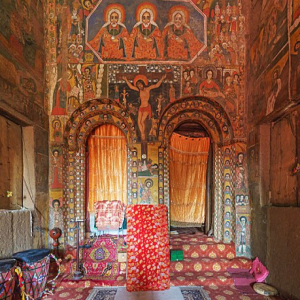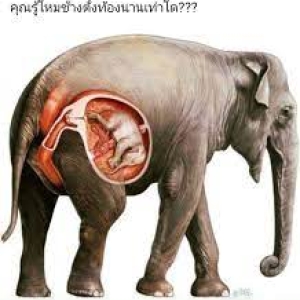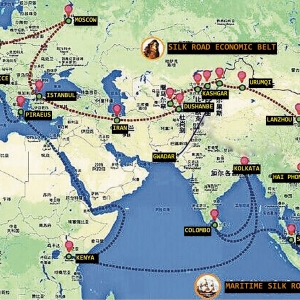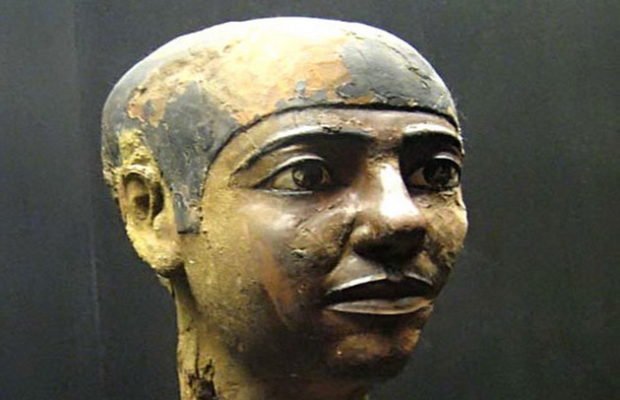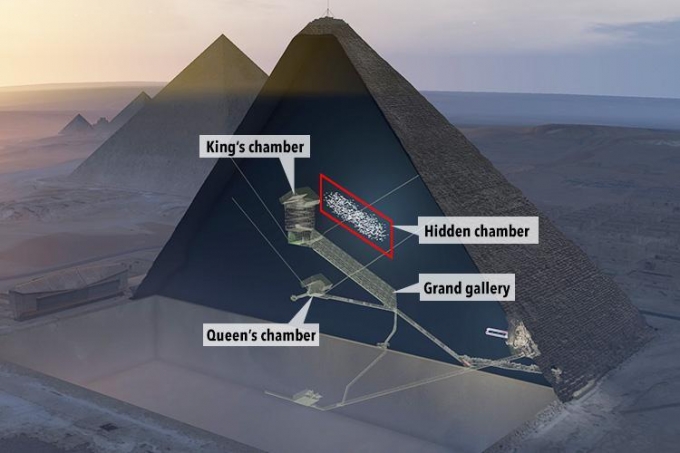ඊජිප්තුවේ පිරමීඩ
ඊජිප්තුවේ පිරමීඩ සම්බන්ධයෙන් විශේෂඥ දැනුමකින් යුතු ඉංග්රීසි ජාතික පුරා විද්යාඥයකු වූ හාවඩ් කාටර් එම කටු සටහන ලියන ලද්දේ 1922 ඔහු විසින් ප්රථම වතාවට ඊජිප්තු පාරාවෝ රජු ටුටැන්කාමන් ගේ විවෘත නොකරන ලද සොහොන්ගෙය සොයා ගැනීමෙන් පසුවයි.
ටුටැන්කාමන් රජුගේ මෙම නිධන්ගත සොහොන් ගෙය සොයා ගැනීම පිරමීඩ ගවේෂණය පිළිබඳ ඉතා තියුණු උනන්දුවක් සහ උද්යෝගයක් ඇති කිරීමට සමත් විය.
Harvard Carter, an English archaeologist with an expert knowledge of the Egyptian pyramids, wrote the sketch in 1922 after he first discovered the unopened tomb of Pharaoh Tutankhamun. The discovery of this ancient tomb of King Tutankhamun aroused a keen interest and excitement in the exploration of the pyramids.
ටුටැන්කාමන් පාරාවෝ රජුගේ සිරුර එම සොහොන්ගෙය තුල තැන්පත් කර නොමැති බව පසුකාලීන ව සොයා ගැනුනත් සෙසු පාරාවෝ වරුන්ගේ මෙතෙක් සොයා නොගත් සොහොන් කුටි කොපමණ සංඛ්යාවක් මෙම පෞරාණික පිරමීඩ තුල සැඟවී ඇත්දැයි ජනයා තුල නොසිඳෙන කුතුහලයක් ඇති කිරීමට මෙම සොයා ගැනීම ඉවහල් විය.
කාන්තාරය මැද සියවස් ගණනක් පිරමීඩ නොසැලී පැවතෙන බව හැරෙන්නට පිරමීඩ අභ්යන්තරයේ කෙතරම් රහස්, නිධාන හෝ මමී සිරුරු සැඟවී තිබේ දැයි අප නිසැක වශයෙන් නොදනිමු.
මෑතකදී ඇමරිකා එක්සත් ජනපදයේ ජනාධිපති අපේක්ෂක බෙන් කාර්සන් සිය කල්පිතය ඉදිරිපත් කරමින් කියා සිටියේ පිරමීඩ මූලික වශයෙන්ම ධාන්යාගාර ලෙස භාවිතා කිරීමට ගොඩනගන ලද බවයි.
ජනාධිපති අපේක්ෂක බෙන් කාර්සන්ගේ මෙම ප්රකාශය ඇමරිකානු ජනමාධ්ය සන්ත්රාසයට පත් කිරීමට සමත් විය.
Recently, US presidential candidate Ben Carson put forward his hypothesis that the pyramids were primarily built to be used as granaries. Presidential candidate Ben Carson's statement came as a shock to the American media.
කෙසේ වෙතත් මේ දක්වා මෙවැනි දඩබ්බර කල්පිත ඉදිරිපත් වීමට ඉඩ සලසමින් පිරමීඩ අභ්යන්තරයේ සත්ය වශයෙන්ම ඇත්තේ මොනවාදැයි ගවේෂණය කිරීමට අපි අසමත් වී ඇත්තේ ඇයි?
පළමු කොටම පිරමීඩ ඉතා විශිෂ්ට පුරා විද්යාත්මක වටිනාකමකින් යුතු නිර්මාණ වීම තුල අභ්යන්තරය පිරික්සීම මගින් සිදු විය හැකි හානි පිළිබඳ දැඩි අවදානමක් පවතියි.

අනෙක් අතට පිරමීඩ ඇතුළත තිබෙන රහස් කාමර සහ උමං මාවත් වලට බලය යොදා ඇතුළු වීමට උත්සාහ කිරීමේදී ඒ එක් එක් පිරමීඩ වලට ආවේණික වූ හයිරෝරේඛණ අභ්යන්තර ආකෘතියට හානි සිදු විය හැකි අතරම පුරා විද්යාත්මක කතිකාව තුල එවැනි ක්රියා නුසුදුසු සහ වගකීම් රහිත බවට විවේචනයට ලක් වීමට ඉඩක් ඇත.
‘අප තේරුම් ගැනීමට උත්සාහ කරන ඒ ඉපැරණි ඓතිහාසික උරුමයන්ට හානි නොකරමු’ යන මතයේ සිට ක්රියාත්මක වන නවීන පුරා විද්යාත්මක ගවේෂණය පිරමීඩ නිර්මාණ කඩා බිඳ දමමින් එහි අභ්යන්තරය පරීක්ෂා කිරීම වළක්වන තවත් මූලික හේතුවකි.
උදාහරණයක් ලෙස පෞරාණික උරුමයන් සංරක්ෂණය කිරීමේ ලාබ නොලබන සංවිධානයක් වන CyArk මෑත කාලීන ව ලෝකයේ පෞරාණික උරුමයන් පන්සීයක් පමණ ඩිජිටල් තාක්ෂණය සහ හානි රහිත ලේසර් කිරණ භාවිතා කරමින් සංරක්ෂණය කිරීමේ ව්යාපෘතියක් ආරම්භ කර තිබේ.
For example, CyArk, a non-profit organization for the preservation of ancient heritage, has recently launched a project to preserve about 500 of the world's ancient heritage using digital technology and harmless laser beams.
පෞරාණික නිර්මාණ සහ පුරාවිද්යාත්මක වටිනාකමකින් යුතු ගොඩනැගිලි කිසිදු හානියකින් හෝ ශාරීරික මැදිහත් වීමකින් තොරව ත්රිමාණ ඡායාරූපකරණයට (3D images) ලක් කිරීමට එම සංවිධානය විසින් භාවිතා කරන නවීන තාක්ෂණයට හැකියාව පවතියි.
The state-of-the-art technology used by the organization is capable of capturing ancient and archeological buildings in 3D without any damage or physical interference.
එලෙස ලබා ගැනෙන ත්රිමාණ ආකෘති එම පෞරාණික වස්තු පිළිබඳ වැඩිදුර අධ්යනය කිරීමටත් ඉදිරි පරපුර වෙනුවෙන් සංරක්ෂණය කිරීමටත් CyArk සංවිධානය කටයුතු කරයි.
ඊජිප්තුවේ ඉපැරණි ධාන්යාගාර ගවේෂණයට ලක්ව ඇති අතර පිරමීඩ කිසි සේත්ම ධාන්යාගාර වෙනුවෙන් නිර්මාණය කෙරුණු ගොඩනැගිලි විය නොහැකි බවයි ‘යුනිවර්සිටි කොලේජ් ලන්ඩන්’ විශ්වවිද්යාලයේ ඊජිප්තු පුරා විද්යා කෞතුකාගාරයේ (University College London’s Petrie Museum) පුරා විද්යාඥ ඇලිස් ස්ටීවන්සන් පවසන්නේ.
ලෝකයේ විශාලතම පිරමීඩය -The largest pyramid in the world

කෙසේ වෙතත් ලෝකයේ විශාලතම පිරමීඩය වශයෙන් හඳුන්වන ඊජිප්තුවේ ‘ගීසා පිරමීඩය’ අභ්යන්තරය සම්බන්ධයෙන් අප දන්නේ ඉතා අල්ප වශයෙනි.
විශාල ගල් කුට්ටි මිලියන දෙකකට වැඩි ප්රමාණයක් යොදා ගෙන මීට වසර තුන් දහසකට පමණ පෙර ගොඩනගන ලද මේ ලෝක උරුමය උසින් අඩි හාරසිය පනහකින් යුතු වෙයි.
මේ වන තෙක් ගවේෂණයට බඳුන් කර ඇති රජුගේ සහ රැජිනගේ කුටී සහ එක් විශිෂ්ට ගැලරියක් හැරුනු කොට ‘ගීසා පිරමීඩයේ’ අභ්යන්තරය ලොවටම තවමත් අභිරහසක්ව පවතියි.
However, little is known about the interior of the 'Pyramid of Giza' in Egypt, known as the largest pyramid in the world. Built over 3,000 million years ago, the World Heritage Site is about 450 feet high. The interior of the Giza Pyramid is still shrouded in mystery, with the exception of the King and Queen's chambers and one magnificent gallery that have been explored so far.
මෑතක දී පුරා විද්යාඥයන් කණ්ඩායමක් තාප ලේඛන යොදා ගනිමින් ‘ගීසා පිරමීඩය’ සම්බන්ධයෙන් ගවේෂණයක් සිදු කළ අතර එයින් හෙළි වූයේ පිරමීඩය තැනීමට යොදා ගෙන ඇති ගල් කුට්ටි එකිනෙකට වෙනස් උෂ්ණත්වයක් සටහන් කරන බවයි.
ඉහත සොයා ගැනීමත් සමග පිරමීඩ පිළිබඳ කුතුහලයක් දක්වන්නන්ට ඔවුන්ගේ ප්රශ්න වලට පිළිතුරු සපයනවා වෙනුවට තව තවත් ප්රශ්න එක් කෙරුණි.
විද්යාඥයින් කණ්ඩායම කියා සිටියේ හිරු නැගීම සහ බැසීමට අනුකූලව පිරමීඩය අභ්යන්තරයේ වාතය ගමන් කරන කුහර ඇති බවත් ඒ හේතුවෙන් මෙලෙස විවිධ ගල් කුට්ටි වෙනස් උෂ්ණත්වයකින් යුතු වීමට ඉඩකඩ පවතින බවත්ය.
ඊට අමතරව 2002 වර්ෂයේදී ගීසා පිරමීඩයේ රැජිනගේ කුටියේ දොරක ගල් කුට්ටියක කුහරයක් විදීමෙන් සැකසූ ප්රවේශයකින් රොබෝ කැමරාවක් ඇතුළු කර උමං මාර්ගයක් සහ තවත් කුටියක ඡායාරූප ගැනීමට පුරා විද්යාත්මක කණ්ඩායමක් සමත් විය.
කෙසේ වෙතත් එලෙස ගනු ලැබූ ඡායාරූප වලින් වැඩි යමක් අනාවරණය කර ගැනීමට නොහැකි වූ බවයි එම විද්යාඥ කණ්ඩායම පසුව ප්රකාශ කළේ.
In addition, in 2002, an archeological team was able to insert a robotic camera into a tunnel and another chamber with an approach made by drilling a hole in a rock in the door of the Queen's chamber of the Pyramid of Giza. However, the team later said they could not find much of the photos.
2011 වසරේ දී පෙර ගවේෂණ වලට භාවිතා කළ රොබෝ කැමරා වලට වඩා දියුණු සහ නම්යශීලී උපාංගයක් යොදා ගනිමින් සහස්රක කිහිපයක් මිනිස් ඇසකට හසු නොවූ රතු හයිරෝරේඛණ ඡායාරූපකරණයට ලක් කිරීමට සමත් විය.

